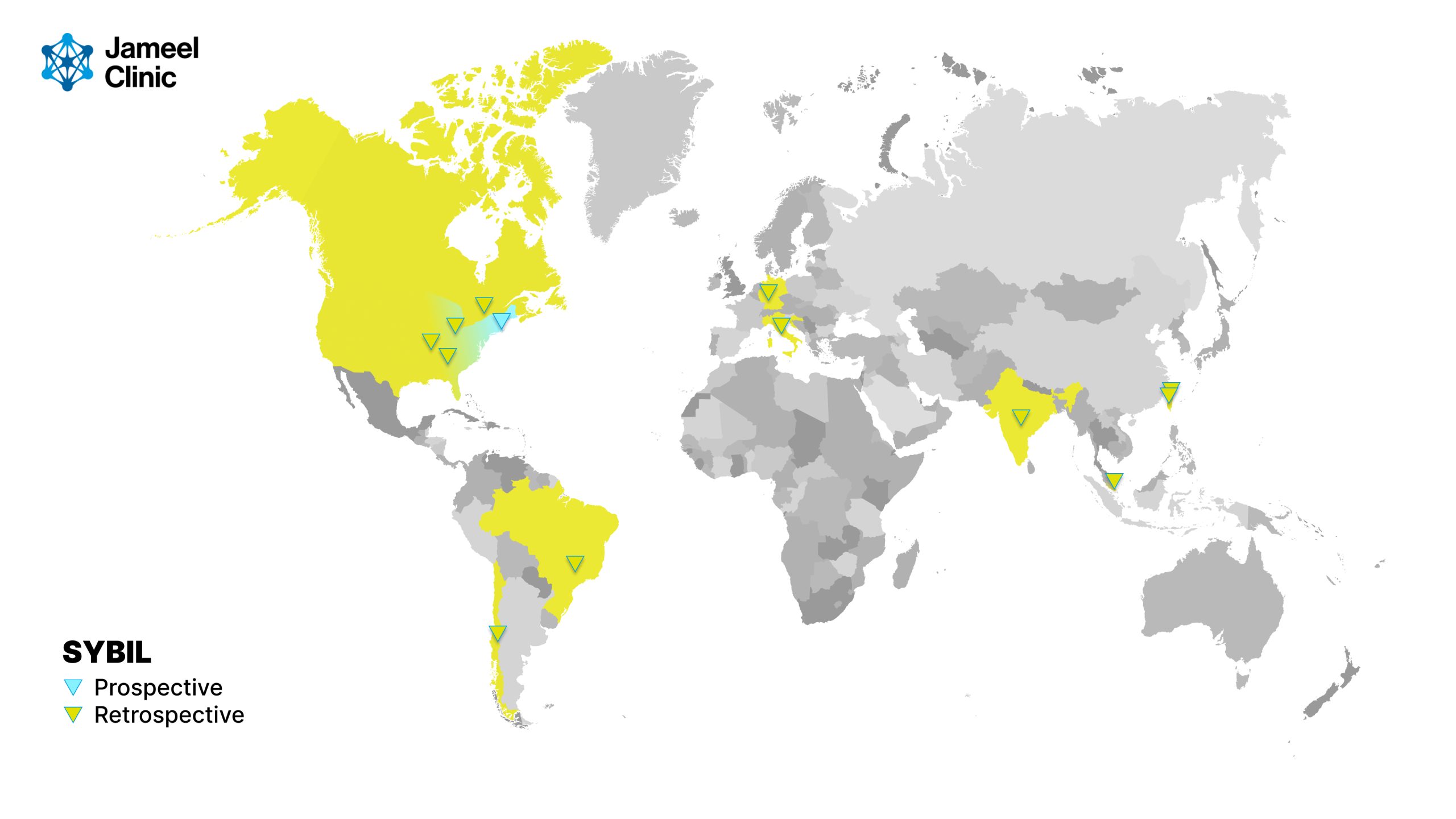Sybil FAQ
What do the terms “prospective” and “retrospective” mean?
Before SYBIL is deployed in a hospital, it is “retrospectively” tested on a large dataset consisting of past medical images taken from patients over the course of 6 years. These images include patients who did not end up developing cancer within 6 years and patients who did end up developing cancer within 6 years. These past images help clinicians ensure the model is working properly before moving on to use the model “prospectively” on real patients.
The map above shows where SYBIL is still being tested retrospectively and where SYBIL is being prospectively tested on real patients.
How does SYBIL work?
SYBIL analyzes the patterns in a patient’s low-dose CT (LDCT) scan then uses an algorithm (or a set of rules to be followed in a calculation) to model a patient’s risk over time. The algorithm was developed by training the software tool on over 28,000 LDCT scans. Researchers then confirmed its accuracy on other sets of LDCTs. In this way, SYBIL gets a lot of experience by looking at many different patients, and then can make better predictions for future patients. If you’re interested in doing a deep dive on the science, the original resarch paper is open-access.
Can the software “see things” that the radiologist cannot see?
Extensive training and experience are what allow radiologists to have a good intuition with respect to risk assessment, usually heavily relying on statistics based on risk factors such as age. SYBIL helps the doctors to formalize this intuition, by proposing a systemic and comprehensive computation of risk over time. Moreover, radiologists usually don’t use images to assess risk, but rather to give a diagnosis if they notice something abnormal on the image. On the other hand, SYBIL can identify patterns in the image that may indicate future risk. SYBIL software, though not yet FDA-approved, has been tested on 3 different datasets across the world on over 27,000 low-dose CT scans has been shown to be more accurate in predicting the risk for developing lung cancer over a 6 year period compared to traditional tools. Researchers also found that SYBIL was accurate across patients who from different race, age, sex, and smoking history categories.
Why are things like family history not included in the tool? Does this affect the tool’s reliability?
SYBIL has been trained to predict risk factors from using only a low-dose CT scan image and uses these factors to provide the final risk assessment score. The software predicts an individual’s risk equally well, with or without the addition of family history data. Traditional risk factors are captured in the medical image but in a way that allows it to still account for them even for patients for which this data is missing.
Does the computer make the decision, or the doctor?
Ultimately, all the decisions are made by doctors, not the computer. SYBIL merely provides physicians with an even more accurate risk assessment tool than the ones on which they already rely.
Is SYBIL validated for use in all women of all ages as a standard of care?
It has been retrospectively validated on 3 diverse test sets from Massachusetts General Hospital, USA; Chang Gung Memorial Hospital, Taiwan; and the National Lung Screening Trial, USA. We are working on validating SYBIL on more data sets from different hospitals around the world.
Can I use SYBIL for my own low-dose CT (LDCT) scan?
You are welcome to access SYBIL to assess your LDCT for lung cancer risk. Due to a high volume of these types of requests, we are not able to use SYBIL to assess your LDCT on your behalf nor are we able to accept requests for enrollment in a clinical trials.
Is SYBIL being deployed in hospitals for all people undergoing lung cancer screening?
SYBIL is currently being assessed in several hospitals around the world as part of our hospital network. However, its current usage is focused primarily on research and it is not being used on all patients undergoing lung cancer screening. We hope that future results from the research will allow SYBIL to be integrated into the standard of care.
Is patient privacy protected in SYBIL’s training process?
SYBIL is trained on de-identified patient data, meaning the data has no personally identifiable information such as a person’s name, email address, social security number, address, etc.


